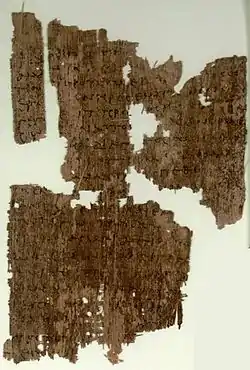Papyrus 106
Papyrus 106 (nach Gregory-Aland mit Sigel 106 bezeichnet) ist eine frühe griechische Abschrift des Neuen Testaments.
| Papyrus 106 | |
|---|---|
 | |
| Name | P. Oxy. LXIV 4445 |
| Text | Johannes 1,29-35; 1,40-46 |
| Sprache | griechisch |
| Datum | 3. Jahrhundert |
| Gefunden | Ägypten |
| Lagerort | Sackler Library |
| Quelle | W. E. H. Cockle, OP LXIV (1997), S. 11–14 |
| Größe | 13 × 8,8 cm |
| Typ | Alexandrinischer Texttyp |
| Kategorie | keine |
Beschreibung
Das Fragment stammt von einer antiken Müllkippe im ägyptischen Oxyrhynchus. Es regnet dort so gut wie nie, darum sind diese Fragmente erhalten geblieben. Dieses Papyrusmanuskript des Johannesevangeliums enthält nur die Verse 1,29–35; 1,40–46. Mittels Paläographie wurde es auf das 3. Jahrhundert datiert.[1][2]
Text
Der griechische Text des Kodex repräsentiert den Alexandrinischen Texttyp und steht damit 66, 75, Codex Sinaiticus und Codex Vaticanus nahe.
Aufbewahrungsort
Die Handschrift wird zurzeit in der Sackler Library unter der Signatur P. Oxy. 4445 in Oxford aufbewahrt.
Einzelnachweise
- INTF, Handschriftliste
- Philip W. Comfort, Encountering the Manuscripts. An Introduction to New Testament Paleography & Textual Criticism, Nashville, Tennessee: Broadman & Holman Publishers, 2005, S. 75.
Literatur
- W. E. H. Cockle, The Oxyrhynchus Papyri LXV (London: 1998), S. 11–14.
- Peter M. Head, The Habits of New Testament Copyists Singular Readings in the Early Fragmentary Papyri of John, Biblica 85 (2004), S. 403.
Weblinks
Abbildungen
- P.Oxy. LXIV 4445 from Papyrology at Oxford's "POxy: Oxyrhynchus Online"
- 106 recto
- 106 verso
Offizielle Registrierung
This article is issued from Wikipedia. The text is licensed under Creative Commons - Attribution - Sharealike. The authors of the article are listed here. Additional terms may apply for the media files, click on images to show image meta data.